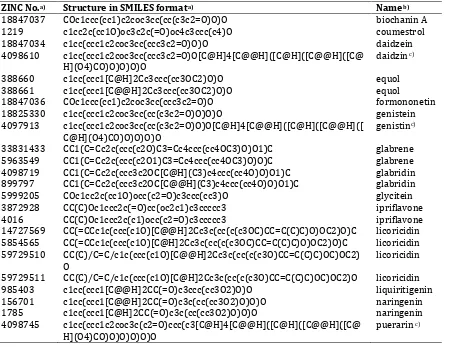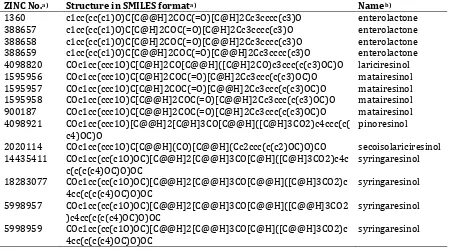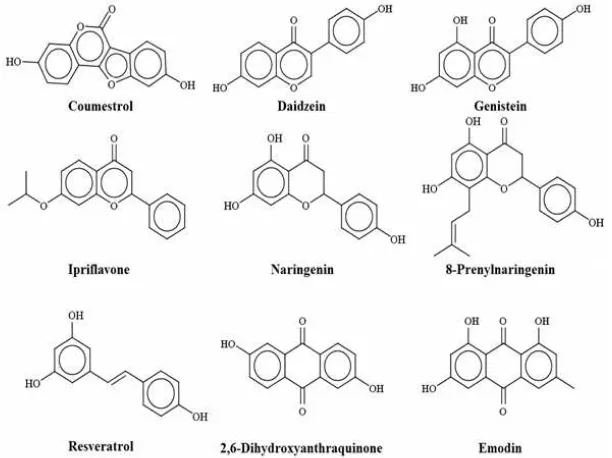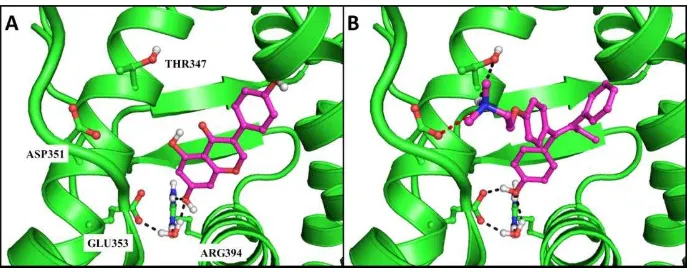ISSN : 1410-5918 Accepted : 21-07-2016
CONSTRUCTION OF THREE DIMENSIONAL STRUCTURES OF
PHYTOESTROGENS CONVERTED FROM SMILES STRING
REPRESENTATIONS FOR SIMULATIONS USING PLANTS DOCKING
SOFTWARE
KONSTRUKSI STRUKTUR TIGA DIMENSI FITOESTROGEN HASIL KONVERSI DARI
SMILES STRING REPRESENTATIONS
UNTUK SIMULASI PENAMBATAN MOLEKULER
MENGGUNAKAN
SOFTWARE
PLANTS
Enade Perdana Istyastono1,* and Nunung Yuniarti2
1Division of Drug Design and Discovery, Faculty of Pharmacy, Sanata Dharma University, Yogyakarta
55282, Indonesia
2Department of Pharmacology and Clinical Pharmacy, Faculty of Pharmacy, Universitas Gadjah Mada,
Sleman, Yogyakarta 55281, Indonesia
ABSTRACT
Phytoestrogens have some important biological effects and could be employed as medicinal resources, for example as cancer chemopreventive agents. Phytoestrogen is defined as a phytochemical that has estrogenic or anti estrogenic effects. However, there is no database providing comprehensive list of phytoestrogen structures. In computer-aided drug discovery, the database is required to perform virtual screening for retrospective validation and structure-based drug design. The research presented in this article attempted to collect a comprehensive list of phytoestrogen structures. Subsequently, the structures were prepared in their three dimensional structures using SPORES1.3 for molecular docking simulations using PLANTS1.2. The ready-to-dock structures were then stored online as phytoestrogens.zip and could be downloaded from http://molmod.org/phytoestrogens.zip. This database contains 30 ready-to-dock unique phytoestrogens with total of 53 different configurations.
Keywords: Phytoestrogen, database, drug discovery, molecular docking
ABSTRAK
Fitoestrogen merupakan senyawa memiliki aktivitas biologis penting bahkan seringkali berpotensi sebagai agen kemoprevensi kanker. Fitoestrogen didefinisikan sebagai senyawa-senyawa alami dari tanaman yang memiliki efek estrogenik atau anti estrogenik. Meskipun demikian, sejauh ini belum ditemui basis data yang menyediakan struktur-struktur fitoestrogen secara komprehensif. Hal ini dapat menghambat penemuan obat berbantukan komputer ketika ketersediaan basis data sangat penting untuk melakukan penapisan virtual guna validasi retrospektif atau perancangan obat berbasis struktur. Penelitian yang disampaikan di artikel ini mencoba mengumpulkan struktur-struktur fitoestrogen secara komprehensif dan melakukan preparasi untuk membuat struktur-struktur tersebut dalam bentuk tiga dimensi dengan aplikasi SPORES1.3 dan siap menjadi berkas masukan untuk simulasi penambatan molekuler PLANTS1.2. Struktur-struktur siap ditambatkan tersebut kemudian disimpan dalam jaringan sebagai phytoestrogens.zip dan bisa diunduh di http://molmod.org/phytoestrogens.zip. Database ini memuat 30 struktur fitoestrogen dengan total 53 konfigurasi yang berbeda yang siap menjadi input simulasi penambatan molekuler.
Kata kunci: Fitoestrogen, basis data, penemuan obat, penambatan molekuler
INTRODUCTION
Drugs discoveries have owed phyto-chemicals since they have become main resources
for inspirations or even lead compounds in the early stages of the discovery and development
Corresponding Author : Enade Perdana Istyastono Email : [email protected]
as starting points to discover novel breast cancer drugs (Balunas et al., 2008; Helferich et al., 2008; Istyastono, 2015; Setiawati et al., 2014a; Shibata et
al., 2011; Vidhya and Devaraj, 2011). In the molecular level, one of the main targets to discover novel breast cancer chemopreventive
agents is estrogen receptor ER (Ali and
Coombes, 2000; Anita et al., 2015, 2012; Istyastono, 2015; Radifar et al., 2013; Setiawati et al., 2014a; Shiau et al., 1998).
Phytochemicals showed that estrogenic or anti estrogenic effects are, by definition, classed as phytoestrogens (Dixon, 2004; Helferich et al., 2008). As ligands for estrogen receptors, these phytochemicals could show the estrogenic or anti estrogenic effects (Helferich et al., 2008). Certain isoflavonoids, flavonoids, stilbenes, and lignans were identified as phytoestrogens (Dixon, 2004). Notably, the best studied phytoestrogen is the soy isoflavone genistein (Dixon, 2004; Helferich et al., 2008; Varinska et al., 2015). The interests on phytoestrogen have emerged not only related to their potency as breast cancer chemopreventive agents (Balunas et al., 2008; Helferich et al., 2008; Setiawati et al., 2014a; Setiawati et al., 2014b), but
also their roles in osteoporosis, cognitive function, cardiovascular disease, immunity and inflammation, and reproduction (Dixon, 2004). However, although many phytochemicals were identified as phytoestrogens (Dixon, 2004; Helferich et al., 2008), the comprehensive list of phytoestrogen is not available yet. The lack of this list hinders the attempts to thoroughly study how
they bind to the receptors especially to ER
(Istyastono, 2015; Pathania et al., 2015; Setiawati
et al., 2014a), which in turn could efficiently assist
the discovery of novel ligands for the receptors (Istyastono et al., 2015a; Istyastono et al., 2015b;
Kufareva et al., 2014; Pathania et al., 2015). This article presents the attempts to collect the structures of known phytoestrogens. The collected structures were virtually prepared using previously published ligand preparation procedures (Istyastono and Setyaningsih, 2015) to be ready for molecular docking simulations. This involved the generations of their three-dimensional (3D) structures (Istyastono and Setyaningsih, 2015; Setiawati et al., 2014a). The
structures in their ready-to-dock formats were subsequently stored online as phytoestrogens.zip and could be obtained from http://molmod.org/phytoestrogens.zip for further usages. Additionally, this article presents also the molecular docking studies of genistein as the best
studied phytoestrogen in the ER binding pocket.
The atomic interactions of the resulted pose to the
ER binding pocket were then compared to the
interactions of the pose of the co-crystal ligand 4-hydroxytamoxifen (4-OHT).
METHODOLOGY
Materials and Instrumentation
The phytochemicals mentioned in Dixon (2004) were used as the starting points. The ZINC and ChEMBL databases were the main references to obtain the phytoestrogen structure (Bento et al., 2014; Irwin et al., 2012). The crystal structure of
ER obtained from the protein data bank PDB
with PDB id of 3ERT (Shiau et al., 1998) was used as the reference structure for molecular docking simulations. Files plants.config, protein.mol2, and water.mol2 to perform the simulations were obtained from Anita et al. (2012).
Computational medicinal chemistry applications employed in this research were SPORES version 1.3 or SPORES1.3 (ten Brink and internet protocol (IP) address of 103.247.10.66. The server has Ubuntu 12.04.3 LTS as the estrogenic or anti estrogenic activity mentioned in Dixon (2004) were obtained from either ZINC database (Irwin et al., 2012) or ChEMBL database (Bento et al., 2014). Each compound was then subjected to Open Babel 2.2.3 conversion software to be converted in its three dimensional (3D) format as a mol2 file. The reprot module in SPORES1.3 was subsequently employed to properly check and assign the mol2 file into a
Visual inspections of the best pose of genistein resulted from the molecular docking simulations using PyMOL (Lill and Danielson, 2011) was then performed to analyze the plausible molecular
determinants of ER -phytoestrogen binding.
RESULTS AND DISCUSSION
According to Dixon (2004), phytoestrogens were classified into isoflavonoid (Table I), flavonoid (Table II) and lignan (Table III) phytoestrogens. Beside those three main classes, there were other phytoestrogens, including chalcone and anthraquinone phytoestrogens (Table IV). Notably, there are still some other phytochemicals which have estrogenic or anti estrogenic effects but not listed in those tables (Tables I-IV), for example eugenol, alizarin, -mangostin (Matsuda et al., 2001; Shibata et al., 2011). Nevertheless, to construct a comprehensive
phytoestrogen structure database requires starting points (Pathania et al., 2015) and the review on phytoestrogens by Dixon (2004) could serve as the starting points since it has covered most phytoestrogen classes and discussed the potent ones (Dixon, 2004; Helferich et al., 2008; Mysinger et al., 2012).
In total, there were 30 unique phytoestrogens presented in Tables I-IV. Since one compound could have more than one 3D configuration, there were 53 structural configurations indicated by the SMILES formats in Tables I-IV. ChEMBL database (Bento et al., 2014) was subsequently inspected to append the information with the biological activities of the listed phytoestrogens at ER . The results are presented in Table V. Only 9 phytoestrogens with
biological activities at ER are listed Table V and
Figure 1).
Table I. Name and structures (in SMILES format) of isoflavonoid phytoestrogens mentioned by Dixon (2004).
ZINC No.a) Structure in SMILES formata) Nameb)
18847037 COc1ccc(cc1)c2coc3cc(cc(c3c2=O)O)O biochanin A 1219 c1cc2c(cc1O)oc3c2c(=O)oc4c3ccc(c4)O coumestrol 18847034 c1cc(ccc1c2coc3cc(ccc3c2=O)O)O daidzein 4098610 c1cc(ccc1c2coc3cc(ccc3c2=O)O[C@H]4[C@@H]([C@H]([C@@H]([C@
H](O4)CO)O)O)O)O
daidzin c)
388660 c1cc(ccc1[C@H]2Cc3ccc(cc3OC2)O)O equol 388661 c1cc(ccc1[C@@H]2Cc3ccc(cc3OC2)O)O equol
18847036 COc1ccc(cc1)c2coc3cc(ccc3c2=O)O formononetin 18825330 c1cc(ccc1c2coc3cc(cc(c3c2=O)O)O)O genistein 4097913 c1cc(ccc1c2coc3cc(cc(c3c2=O)O)O[C@H]4[C@@H]([C@H]([C@@H]([
C@H](O4)CO)O)O)O)O
genistinc)
33831433 CC1(C=Cc2c(ccc(c2O)C3=Cc4ccc(cc4OC3)O)O1)C glabrene 5963549 CC1(C=Cc2c(ccc(c2O1)C3=Cc4ccc(cc4OC3)O)O)C glabrene 4098719 CC1(C=Cc2c(ccc3c2OC[C@H](C3)c4ccc(cc4O)O)O1)C glabridin 899797 CC1(C=Cc2c(ccc3c2OC[C@@H](C3)c4ccc(cc4O)O)O1)C glabridin 5999205 COc1cc2c(cc1O)occ(c2=O)c3ccc(cc3)O glycitein 3872928 CC(C)Oc1ccc2c(=O)cc(oc2c1)c3ccccc3 ipriflavone 4016 CC(C)Oc1ccc2c(c1)occ(c2=O)c3ccccc3 ipriflavone 14727569 CC(=CCc1c(ccc(c1O)[C@@H]2Cc3c(cc(c(c3OC)CC=C(C)C)O)OC2)O)C licoricidin 5854565 CC(=CCc1c(ccc(c1O)[C@H]2Cc3c(cc(c(c3OC)CC=C(C)C)O)OC2)O)C licoricidin 59729510 CC(C)/C=C/c1c(ccc(c1O)[C@@H]2Cc3c(cc(c(c3O)CC=C(C)C)OC)OC2)
O
licoricidin
59729511 CC(C)/C=C/c1c(ccc(c1O)[C@H]2Cc3c(cc(c(c3O)CC=C(C)C)OC)OC2)O licoricidin 985403 c1cc(ccc1[C@@H]2CC(=O)c3ccc(cc3O2)O)O liquiritigenin 156701 c1cc(ccc1[C@@H]2CC(=O)c3c(cc(cc3O2)O)O)O naringenin 1785 c1cc(ccc1[C@H]2CC(=O)c3c(cc(cc3O2)O)O)O naringenin 4098745 c1cc(ccc1c2coc3c(c2=O)ccc(c3[C@H]4[C@@H]([C@H]([C@@H]([C@
H](O4)CO)O)O)O)O)O
puerarin c)
a)One compound with more than one possible 3D configuration could have more than one structure in SMILES format
(Bento et al., 2014; Irwin et al., 2012); b)As mentioned by Dixon (2004); c)For glycosides, only one configuration is
Table II. Name and structures (in SMILES format) of flavonoid phytoestrogens mentioned by Dixon (2004).
ZINC No.a) Structure in SMILES formata) Nameb)
3873159 CC(=CCc1c(c(c2c(c1O)C(=O)C[C@H](O2)c3ccc(cc3)O)CC=C( C)C)O)C
6,8-diprenylnaringenin
4098363 CC(=CCc1c(cc2c(c1O)C(=O)C[C@H](O2)c3ccc(cc3)O)O)C 6-prenylnaringenin 5854068 CC(=CCC/C(=C/Cc1c(cc(c2c1O[C@@H](CC2=O)c3ccc(cc3)O)
O)O)/C)C
8-geranylnaringenin
39451 CC(=CCc1c(cc(c2c1O[C@H](CC2=O)c3ccc(cc3)O)O)O)C 8-prenylnaringenin 39452 CC(=CCc1c(cc(c2c1O[C@@H](CC2=O)c3ccc(cc3)O)O)O)C 8-prenylnaringenin 12353732 c1cc(ccc1/C=C\c2cc(cc(c2)O)O)O resveratrolc)
6787 c1cc(ccc1/C=C/c2cc(cc(c2)O)O)O resveratrolc)
2008845 CC(=CC[C@@H](Cc1c(cc(c2c1O[C@H](CC2=O)c3ccc(cc3O)O )O)O)C(=C)C)C
sophoraflavanone_G
2008847 CC(=CC[C@H](Cc1c(cc(c2c1O[C@H](CC2=O)c3ccc(cc3O)O)O )O)C(=C)C)C
sophoraflavanone_G
2008848 CC(=CC[C@@H](Cc1c(cc(c2c1O[C@@H](CC2=O)c3ccc(cc3O) O)O)O)C(=C)C)C
sophoraflavanone_G
2008850 CC(=CC[C@H](Cc1c(cc(c2c1O[C@@H](CC2=O)c3ccc(cc3O)O )O)O)C(=C)C)C
sophoraflavanone_G
a)One compound with more than one possible 3D configuration could have more than one structure in
SMILES format (Bento et al., 2014; Irwin et al., 2012); b)As mentioned by Dixon (2004); c)Resveratrol was
classified here since the biosynthesis was related to flavonoids (Dixon, 2004).
Table III.Name and structures (in SMILES format) of lignan phytoestrogens mentioned by Dixon (2004).
ZINC No.a) Structure in SMILES formata) Nameb)
1360 c1cc(cc(c1)O)C[C@@H]2COC(=O)[C@H]2Cc3cccc(c3)O enterolactone 388657 c1cc(cc(c1)O)C[C@H]2COC(=O)[C@H]2Cc3cccc(c3)O enterolactone 388658 c1cc(cc(c1)O)C[C@H]2COC(=O)[C@@H]2Cc3cccc(c3)O enterolactone 388659 c1cc(cc(c1)O)C[C@@H]2COC(=O)[C@@H]2Cc3cccc(c3)O enterolactone 4098820 COc1cc(ccc1O)C[C@H]2CO[C@@H]([C@H]2CO)c3ccc(c(c3)OC)O lariciresinol 1595956 COc1cc(ccc1O)C[C@H]2COC(=O)[C@H]2Cc3ccc(c(c3)OC)O matairesinol 1595957 COc1cc(ccc1O)C[C@H]2COC(=O)[C@@H]2Cc3ccc(c(c3)OC)O matairesinol 1595958 COc1cc(ccc1O)C[C@@H]2COC(=O)[C@@H]2Cc3ccc(c(c3)OC)O matairesinol 900187 COc1cc(ccc1O)C[C@@H]2COC(=O)[C@H]2Cc3ccc(c(c3)OC)O matairesinol 4098921 COc1cc(ccc1O)[C@@H]2[C@H]3CO[C@@H]([C@H]3CO2)c4ccc(c(
c4)OC)O
pinoresinol
2020114 COc1cc(ccc1O)C[C@@H](CO)[C@@H](Cc2ccc(c(c2)OC)O)CO secoisolariciresinol 14435411 COc1cc(cc(c1O)OC)[C@@H]2[C@@H]3CO[C@H]([C@H]3CO2)c4c
c(c(c(c4)OC)O)OC
syringaresinol
18283077 COc1cc(cc(c1O)OC)[C@@H]2[C@@H]3CO[C@@H]([C@H]3CO2)c 4cc(c(c(c4)OC)O)OC
syringaresinol
5998957 COc1cc(cc(c1O)OC)[C@@H]2[C@@H]3CO[C@@H]([C@@H]3CO2 )c4cc(c(c(c4)OC)O)OC
syringaresinol
5998959 COc1cc(cc(c1O)OC)[C@@H]2[C@@H]3CO[C@H]([C@@H]3CO2)c 4cc(c(c(c4)OC)O)OC
syringaresinol
a)One compound with more than one possible 3D configuration could have more than one structure in
Remarkably, all listed active phytoestrogens shared similar pharmacophore, i.e. they had hydroxyl phenolic and carbonyl moieties separated by 5 heavy atoms (Table V and Figure 1).
For the purpose of creating the database of the ready-to-dock phytoestrogens, an smi
file named phytoestrogens.smi containing all listed structures in Tables I-IV was created. The structure of the file is as follows: Table IV. Name and structures (in SMILES format) of other classes (chalcone and anthraquinone) phytoestrogens mentioned by Dixon (2004).
ZINC No.a) Structure in SMILES formata) Nameb)
3860201 c1cc2c(cc1O)C(=O)c3ccc(cc3C2=O)O 2,6-dihydroxyanthraquinone 3824868 Cc1cc2c(c(c1)O)C(=O)c3c(cc(cc3O)O)C2=O emodin
3869608 c1cc(ccc1/C=C/C(=O)c2ccc(cc2O)O)O isoliquiritigenin
a)One compound with more than one possible 3D configuration could have more than one structure in SMILES format
(Bento et al., 2014; Irwin et al., 2012); b)As mentioned by Dixon (2004).
Table V.Biological activities (IC50 at ER of some listed phytoestrogens (Bento et al., 2014).
Name ChEMBL
a)
IC50 (nM)b)
Compound Identity Assay Identity
Coumestrol CHEMBL30707 CHEMBL827788 76 Daidzein CHEMBL8145 CHEMBL1219560 450 Genistein CHEMBL44 CHEMBL891640 395 Ipriflavone CHEMBL165790 CHEMBL1909145 Not active Naringenin CHEMBL9352 CHEMBL909843 75,302 8-prenylnaringenin CHEMBL460647 CHEMBL909843 57 Resveratrol CHEMBL165 CHEMBL1909145 Not active 2,6-Dihydroxyanthraquinone CHEMBL298398 CHEMBL679893 1100 Emodin CHEMBL289277 CHEMBL679893 2700
a)Ref: (Bento et al., 2014); b)If there were more than one biological activities listed in the database, the most recent
one was selected.
[SMILES] molmodID_zincID_name. For example, biochanin A (Table I) was written in the first line of phytoestrogens.smi as follows: COc1ccc(cc1)c2coc3cc(cc(c3c2=O)O)O
pe01_18847037_biochaninA. Following the procedures aforementioned resulted in a zip file with size of 70 kilobytes. This file has been uploaded and attached to http://molmod.org/ and could therefore be obtained from http://molmod.org/phytoestrogens.zip. In order to check the readiness of the uploaded ready-to-dock mol2 file, further molecular docking
simulations employing previously published procedure by Anita et al. (2012) were performed. The docking simulations ran without giving any error messages. This confirmed that the uploaded input files were the ready-to-dock structures. For further analysis by public, the docking results were zipped in a zip file with size of 12 megabytes and the zip file was uploaded to http://molmod.org/ and can be obtained from http://molmod.org/phytoestrogens.PLANTS.zip.
The best studied phytoestrogen genistein (Dixon, 2004; Helferich et al., 2008; Varinska et al., Figure 2. Flowchart of the ligand preparation process suggested in this article with genistein as the representative.
2015) was selected as the representative for visual inspections. The process of transforming genistein from its SMILES format to the ready-to-dock 3D format is depicted in Figure 2. The best docking
pose of genistein in the ER binding pocket is
presented in Figure 3.
Based on Figures 2 and 3, it could be concluded that the resulted mol2 files were ready to be docked using PLANTS1.2. Moreover, by examining the binding poses of genistein and
4-O(T in the ER binding pocket Figure , the
important binding interactions could be identified: the hydrogen bond network between genistein, GLU353, ARG394, and the conserved water
plausible aromatic residue as the molecular determinant in the ER binding pocket is TRP (Istyastono, 2015).
CONCLUSION
The database of ready-to-dock 3D structures of phytoestrogens resulted in this research could be employed further to study the atomic level of their estrogenic or anti estrogenic activities. Genistein as the representative phytoestrogen employed further in molecular
docking simulations into ER has unraveled some
the molecular determinants in the ER -ligand
binding: GLU353, TRP383 and ARG394.
ACKNOWLEDGMENT
This work was financially supported by the Hibah Kompetensi Research Grant from the Ministry of Research, Technology, and Higher Education of the Republic of Indonesia. The authors thank Molecular Modeling Center
MOLMOD.ORG for providing space in its website
http://molmod.org/ to upload the database resulted in this research and C.V. Digikom Multimedia Pratama (http://digikom.co.id/) for providing instruments used in the research. Istyastono, E.P. 2012. Structure-based design
of eugenol analogs as potential estrogen receptor antagonists. Bioinformation 8: 901– 906.
Anita, Y., Sundowo, A., Dewi, N.L.P., Filailla, E., Mulyani, H., Risdian, C., Banjarnahor, S., Hanafi, M. and Istyastono, E.P. 2015. Biotransformation of eugenol to dehydroeugenol catalyzed by Brassica juncea
peroxidase and its cytotoxicity activities.
Procedia Chem. 16: 265–271.
Balunas, M.J., Su, B., Brueggemeier, R.W. and Kinghorn, A.D. 2008. Xanthones from the botanical dietary supplement mangosteen (Garcinia mangostana) with aromatase inhibitory activity. J. Nat. Prod. 71: 1161– 1166.
Bento, A.P., Gaulton, A., Hersey, A., Bellis, L.J., Chambers, J., Davies, M., Krüger, F.A., Light, Y., Mak, L., McGlinchey, S., Nowotka, M., Papadatos, G., Santos, R. and Overington, J.P. 2014. The ChEMBL bioactivity database: An update. Nucl. Acids Res. 42: 1083–1090. Brusotti, G., Cesari, I., Dentamaro, A., Caccialanza,
G. and Massolini, G. 2014. Isolation and characterization of bioactive compounds from plant resources: The role of analysis in the ethnopharmacological approach. J. Pharm. Biomed. Anal. 87: 218–228.
Cardoso, F. and Senkus, E., 2015. Breast cancer in 2014: A call back to reality! Nat. Rev. Clin. Oncol. 12, 67–68.
Dixon, R.A. 2004. Phytoestrogens. Annu. Rev. Plant Biol. 55: 225–261.
Efferth, T. and Koch, E. 2011. Complex interactions between phytochemicals. The multi-target therapeutic concept of phytotherapy. Curr. Drug Targets 12: 122–132.
Helferich, W.G., Andrade, J.E. and Hoagland, M.S. 2008. Phytoestrogens and breast cancer: a complex story. Inflammopharmacology 16: 219–26.
Irwin, J.J., Sterling, T., Mysinger, M.M., Bolstad, E.S. and Coleman, R.G., 2012. ZINC: A free tool to discover chemistry for biology. J. Chem. Inf. Model. 52: 1757–1768.
Istyastono, E.P. 2015. Employing recursive partition and regression tree method to increase the quality of structure-based virtual screening in the estrogen receptor alpha ligands identification. Asian J. Pharm. Clin. Res. 8: 21–24.
Istyastono, E.P., Kooistra, A.J., Vischer, H., Kuijer, M., Roumen, L., Nijmeijer, S., Smits, R., de Esch, I., Leurs, R. and de Graaf, C., 2015a.
Commun. 6: 1003–1017.
Istyastono, E.P., Riswanto, F.D.O., and Yuliani, S.H. 2015b. Computer-aided drug repurposing: a
cyclooxygenase-2 inhibitor celecoxib as a ligand for estrogen receptor alpha. Indones. J. Chem. 15: 274–280.
Istyastono, E.P. and Setyaningsih, D., 2015. Construction and retrospective validation of structure-based virtual screening protocols to identify potent ligands for human adrenergic 2 receptor. Indones. J. Pharm. 26:
20–28.
Korb, O., Stützle, T. and Exner, T.E., 2007. An ant colony optimization approach to flexible protein–ligand docking. Proc. IEEE Swarm Intell. Symp. 1: 115–134.
Korb, O., Stützle, T. and Exner, T.E., 2009. Empirical scoring functions for advanced protein-ligand docking with PLANTS. J. Chem. Inf. Model. 49: 84–96.
Kufareva, I., Katritch, V., Stevens, R.C. and Abagyan, R. 2014. Advances in GPCR modeling evaluated by the GPCR DOCK 2013 assessment: Meeting new challenges.
Structure 22: 1120–1139.
Lill, M.A. and Danielson, M.L. 2011. Computer-aided drug design platform using PyMOL. J. Comput. Aided Mol. Des. 25: 13–19.
Matsuda, H., Shimoda, H., Morikawa, T. and Yoshikawa, M. 2001. Phytoestrogens from the roots of Polygonum cuspidatum
(Polygonaceae): Structure-requirement of hydroxyanthraquinones for estrogenic activity. Bioorg. Med. Chem. Lett. 11: 1839– 1842.
Mysinger, M.M., Carchia, M., Irwin, J.J. and Shoichet, B.K. 2012. Directory of Useful Decoys, Enhanced (DUD-E): Better ligands and decoys for better benchmarking. J. Med. Chem. 55: 6582–6594.
O’Boyle, N.M., Banck, M., James, C.A., Morley, C.,
Vandermeersch, T., and Hutchison, G.R. 2011. Open Babel: An open chemical toolbox.
J. Cheminform. 3: 33–47.
Pathania, S., Ramakrishnan, S.M. and Bagler, G. 2015. Phytochemica: A platform to explore
phytochemicals of medicinal plants.
Database 10.1093/database/bav075: 1–8. Radifar, M., Yuniarti, N., Istyastono, E.P. 2013.
PyPLIF: Python-based protein-ligand interaction fingerprinting. Bioinformation 9: 325–328.
Setiawati, A., Riswanto, F.D.O., Yuliani, S.H. and Istyastono, E.P. 2014a. Retrospective
validation of a structure-based virtual screening protocol to identify ligands for estrogen receptor alpha and its application to identify the alpha-mangostin binding pose. Indo. J. Chem. 14: 103–108.
Setiawati, A., Riswanto, F.O.D., Yuliani, S.H. and Istyastono, E.P. 2014b. Anticancer activity of
mangosteen pericarp dry extract against MCF-7 breast cancer cell line though receptor/coactivator recognition and the antagonism of this interaction by tamoxifen.
Cell 95: 927–937.
Shibata, M.-A., Iinuma, M., Morimoto, J., Kurose, H., Akamatsu, K., Okuno, Y., Akao, Y. and Otsuki,
Y. . -Mangostin extracted from the pericarp of the mangosteen (Garcinia mangostana Linn) reduces tumor growth and lymph node metastasis in an immunocompetent xenograft model of metastatic mammary cancer carrying a p53 mutation. BMC Med. 9: 69.
ten Brink, T. and Exner, T.E., 2009. Influence of protonation, tautomeric, and stereoisomeric states on protein-ligand docking results. J. Chem. Inf. Model. 49: 1535–1546.
Varinska, L., Gal, P., Mojzisova, G., Mirossay, L. and Mojzis, J. 2015. Soy and breast cancer: Focus on angiogenesis. Int. J. Mol. Sci. 16: 11728– 11749.



